Hi beautiful,
Let’s talk about the power of a vision board.
They’re a great way to stay focused on what truly matters in your life. They are tangible representations of your goals, a visual map of where you want your life to go.
Whether you’re working on building stronger relationships, growing your career, or planning to travel to new places, a vision board keeps you motivated and on track.
Curious about how to set one up? Let’s dive into the details and explore how to make a vision board and how it is helpful to you.
What is a Vision Board?

A vision board is a tool to visualize your goals. It shows what you want to achieve or who you want to become. It’s made up of pictures, quotes, and affirmations that inspire you.
You can create a vision board in two ways:
- physical or digital
Physical Vision Board
A physical vision board is created on a poster or board. You cut out pictures and write notes by hand. It’s creative and fun.
Digital Vision Board
A digital vision board is made on your phone or computer. You use apps or software to arrange pictures and words. It’s easy to edit and take with you anywhere.
How to Make a Vision Board
Gather Your Materials
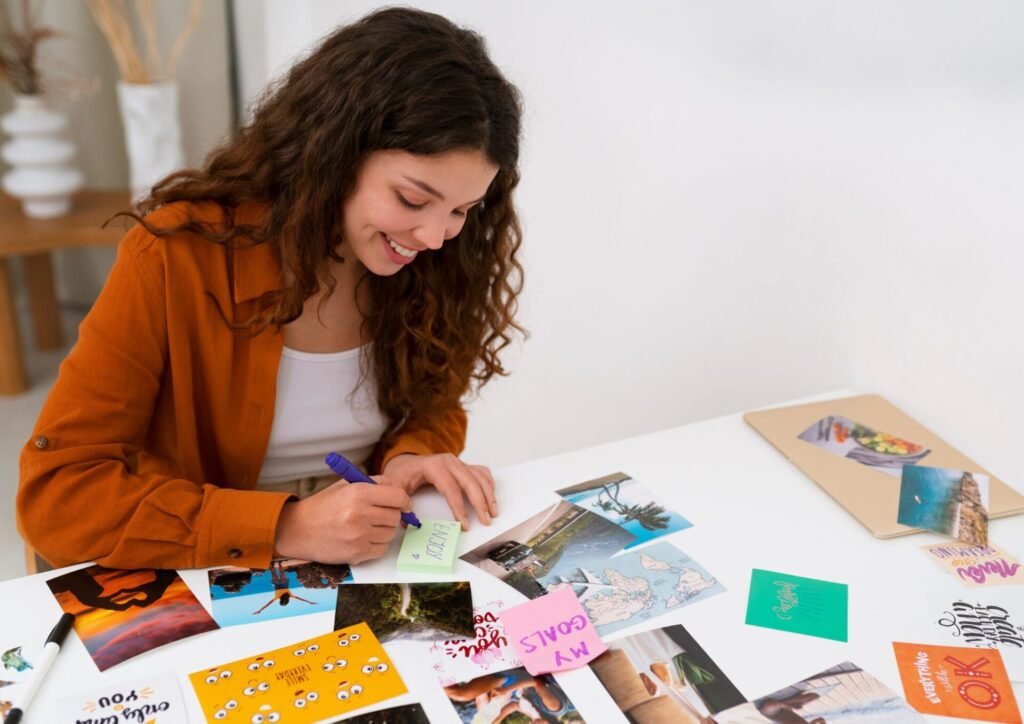
Before creating your vision board, choose between a physical or digital version.
Physical Vision Board Essentials:
- Poster Board or Corkboard: Provides a base for your collage.
- Magazines: Source for images and quotes.
- Scissors: To cut out pictures and text.
- Glue or Push Pins: To attach your cutouts to the board.
- Markers: For adding personal notes or doodles.
- Decorative Elements: Stickers, washi tape, or other items to personalize your board.
Digital Vision Board:
- Computer or Tablet: Your main tool for creating your board.
- Vision Board Software or Apps: Use platforms like Canva, Pinterest, or Adobe Spark to design your digital board. These tools allow you to drag and drop images, text, and other elements easily.
Set Clear Goals
To make your vision board work for you, define what you want to achieve in different areas of your life:
Areas to Focus On
- Career Goals
- Define the professional milestones you want to reach.
- Examples: Landing a managerial position, mastering a new skill, or switching to a dream industry.
- Health Goals
- Your physical and mental well-being.
- Examples: Starting a daily exercise routine, improving your diet, or adopting mindfulness practices.
- Relationship Goals
- Relationships you value and want to nurture or create.
- Examples: Strengthening bonds with family, meeting new friends, or building romantic connections.
- Personal Growth Goals
- Areas where you’d like to grow personally.
- Examples: Learning a new language, taking up painting, or achieving a bucket-list goal.
- Professional Development Goals
- Advancing in your career or building expertise.
- Examples: Earning a certification, becoming a thought leader, or mentoring others in your field.
- Financial Goals
- Financial stability and growth.
- Examples: Saving for a home, paying off student loans, or building a diverse investment portfolio.
Choose Your Visuals
Choose the right visuals to make your vision board effective. Gather images and quotes that resonate with your goals.
Where to Find Your Visuals
- Magazines: A classic source for vibrant and diverse images.
- Websites: Use platforms like Pinterest, Instagram, and Unsplash to find high-quality visuals.
- Personal Photos: Include meaningful pictures that evoke positive emotions.
- Custom Creations: Design your own visuals or text in tools like Canva for a personalized touch.
Organize Your Vision Board
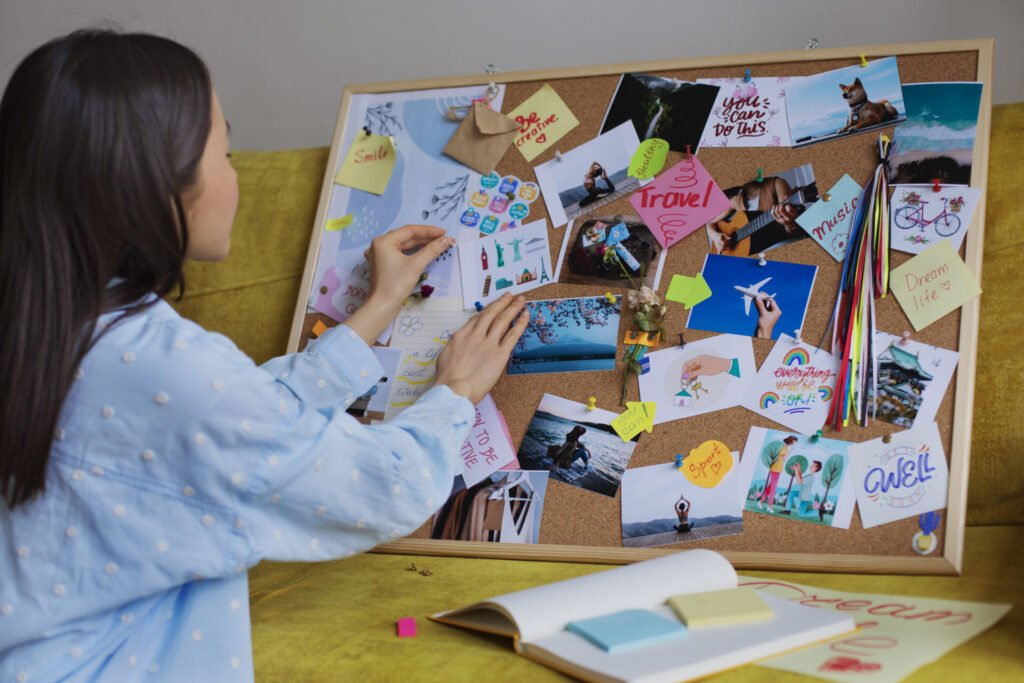
Once you’ve gathered everything, arrange your images and quotes so they’re easy to focus on and visually appealing. Group similar goals together or mix them up for a holistic view of your aspirations.
Select a Layout Style
- Category Layout
- What it is: Divide your board into distinct sections for areas like career, health, relationships, and personal growth.
- Why it works: It provides clear focus, making it easier to concentrate on specific goals.
- How to create it: Use borders, labels, or color-coding to define each section.
- Free-Form Design
- What it is: A more flexible and creative arrangement without predefined sections.
- Why it works: It allows for organic flow and creativity, perfect if you’re drawn to a more dynamic style.
- How to create it: Arrange visuals intuitively, letting your instincts guide the placement.
Balance Aesthetics and Functionality
- Visual Appeal
- Colors: Choose a palette that energizes or soothes you, depending on your goals. For example, calming blues for mindfulness or bold reds for career ambition.
- Arrangement: Layer and overlap visuals for depth, or keep them evenly spaced for a clean look.
- Functionality
- Declutter: Leave breathing room around visuals so each element stands out.
- Accessibility: Use a layout that allows you to easily focus on individual goals without distractions.
Strategic Placement
- Prominent Goals: Place your most important dreams or immediate priorities in the center or top of the board, where they’ll catch your eye.
- Secondary Goals: Arrange supporting or long-term goals around the edges or lower sections.
Personal Touches and Refreshing Your Board
- Memorable Tokens: Add personal items like travel tickets, handwritten affirmations, or small souvenirs. These elements make your board uniquely yours and evoke positive emotions.
- Update and Refresh: As your goals evolve, don’t hesitate to replace outdated visuals or add new ones. Keeping your board fresh ensures it stays aligned with your current aspirations.
How to Create a Physical Vision Board
- Prepare Your Workspace: Choose a clean, comfortable space with enough room to spread out materials.
- Collect and Cut Visuals: Use magazines or print images/quotes that represent your goals, then cut them out.
- Arrange Your Layout: Experiment with different arrangements on the board before gluing anything down.
- Glue Items Securely: Attach images and quotes using glue sticks or craft glue, ensuring no wrinkles.
- Decorate Your Board: Add stickers, ribbons, or other decorations to personalize and enhance its appeal.
How to Create a Digital Vision Board
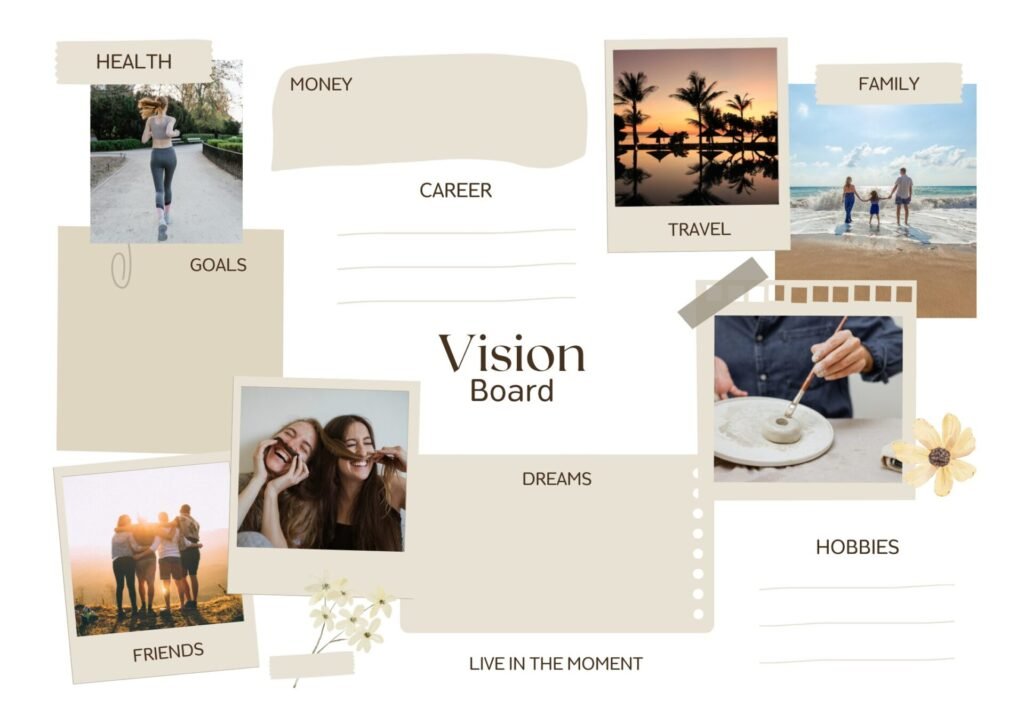
- Choose a Platform: Use tools like Canva, Pinterest, or Adobe Spark for designing and customizing.
- Collect Digital Images: Save visuals and quotes from websites or stock photo libraries.
- Design Your Board: Arrange and edit images using the platform’s tools, ensuring an appealing and clear layout.
- Save and Set as Wallpaper: Save the board as an image file and use it as your desktop or phone background for daily inspiration.
Activate Your Vision Board
To maximize the impact of your vision board, incorporate these techniques into your daily routine:
Daily Visualization
Spend a few minutes imagining yourself achieving your goals. Feel the emotions of success—joy, pride, and fulfillment.
Positive Affirmations

Affirmations are positive statements that boost your mindset and help you achieve your goals.
Here are some examples:
- “I am worthy of success and happiness.”
- “Every day, I am growing and improving.”
- “I have the power to create the life I desire.”
- “I am resilient and can overcome any challenge.”
- “Opportunities come to me easily and effortlessly.”
- “I am in control of my thoughts and emotions.”
- “I attract positive energy and supportive people.”
- “My efforts are leading to my desired outcomes.”
- “I am confident in my abilities and decisions.”
- “Success is within my reach and I am capable of achieving it.”
Place Your Vision Board Where You See it Frequently
Keep your vision board where you’ll see it often, such as:
- Bedroom: Near your bed or a wall you face frequently.
- Office: In your workspace to stay motivated.
- Mirror: Next to a mirror you use daily.
- Bathroom: On the door or near the sink for constant reminders.
Review and Update Your Vision Board
- Assess Alignment: Ensure it reflects your current goals.
- Track Progress: Celebrate and update completed goals.
- Make Adjustments: Add new aspirations and replace outdated visuals.
How to stay motivated to achieve your goals?
Maintaining motivation is essential for reaching your goals.
Here are two effective strategies:
Journaling:
- Track your daily workouts and progress.
- Record milestones and challenges in your career.
- Reflect on personal growth and new skills learned.
Positive Environment:
- Engage with friends or mentors who encourage you.
- Create an inspiring workspace with motivational quotes.
- Surround yourself with positive and uplifting influences.
Why Vision Boards are So Powerful
Vision boards are effective because they use the power of visualization. By regularly viewing images and reminders of your goals, you train your mind to focus on achieving them.
A study in the “Journal of Consulting Psychology” says that people who used visualization techniques improved their performance. They took more steps toward their goals compared to those who didn’t use visualization.
Vision boards also connect with the Law of Attraction. According to the law of attraction positive thoughts attract positive outcomes.
For example, if you visualize getting a promotion at work, you’ll seize opportunities that help you achieve that promotion.
How Vision Boards Helped Celebrities Achieve Their Most Ambitious Goals
Many people, from celebrities to everyday individuals, have reached remarkable milestones using vision boards.
Oprah Winfrey
Oprah is a well-known advocate of vision boards. She says they helped her achieve many of her dreams, including her incredible career and personal growth.
Jim Carrey
Jim Carrey wrote himself a check for $10 million for acting. He carried it around for years. Later, he earned exactly that amount for “Dumb and Dumber.”
Sarah Centrella
Sarah used her vision board to plan her travels. She dreamed of visiting over 20 countries and made it happen with the help of her board.
Now, she teaches others how to use vision boards to achieve their goals.
Conclusion
Setting goals is the first step in turning the invisible into the visible.
Anthony Robbins
Creating a vision board is just the start. The real power lies in consistency. Make it a daily habit to engage with your vision board. This keeps your goals at the forefront of your mind.
Stay committed to your vision, even when challenges arise. Your vision board is a powerful tool, but it’s your dedication that makes it truly effective.
Keep your goals in view, stay motivated, and let your commitment drive your success.
FAQs
How to create a vision board for your life?
To create a vision board for your life, consider the main areas you want to improve, like your career, relationships, health, and personal growth. Collect images and quotes that match these goals. Arrange them on your board to reflect your overall vision.
How can I write my vision?
To write your vision:
Identify your values: What’s most important to you?
Be specific: Imagine your ideal future.
Keep it positive: Focus on what you want, not what you don’t.
Write in present tense: Make it feel real.
Make it inspiring: Your vision should excite and motivate you.
How to create a vision board on a phone?
To create a vision board on your phone, pick an app like Canva, Pinterest, Adobe Spark, or Vision Board App. Find images and quotes that show your goals. Use the app to arrange these visuals. Once you’re happy with the design, save it and set it as your phone’s wallpaper.
What not to put on a vision board?
Don’t put vague, negative, or unrealistic items on your vision board. Instead, focus on clear, positive goals that truly inspire you.
What is a vision board example?
A vision board example includes pictures of your dream home, vacation spots, fitness goals, and career milestones. For instance, if you want to start a business, include images of a successful office, quotes about entrepreneurship, and symbols related to your business dreams.

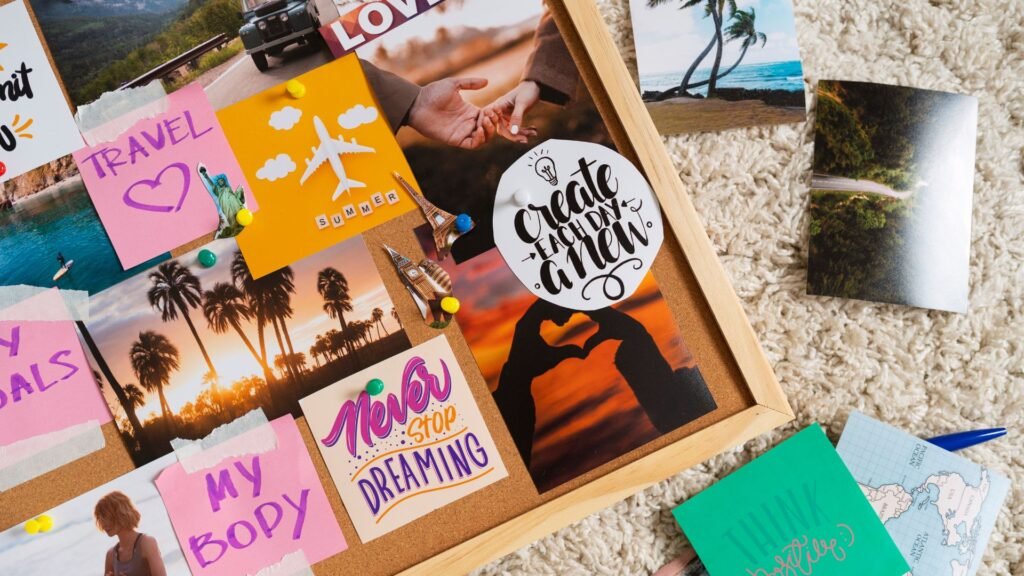
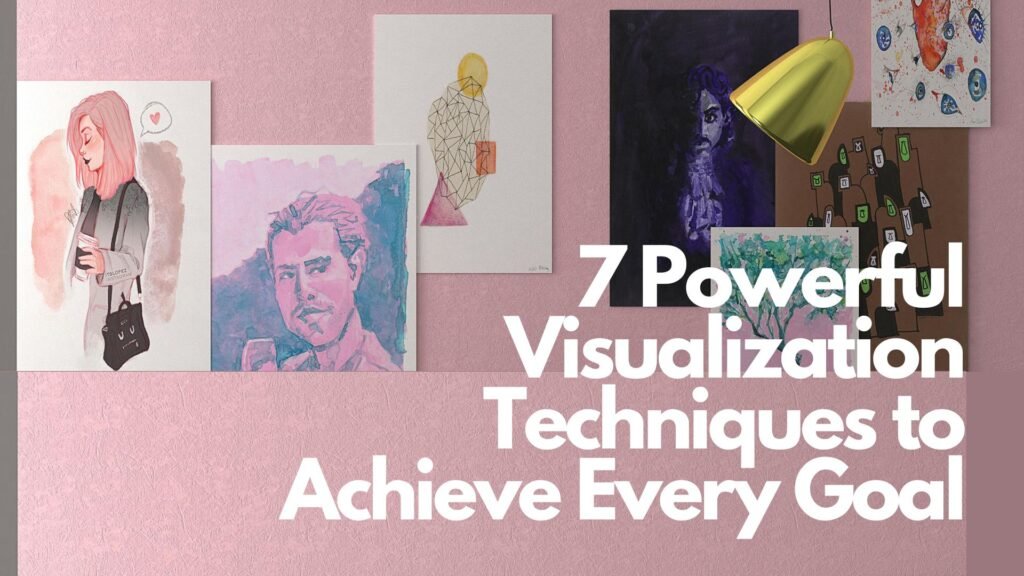
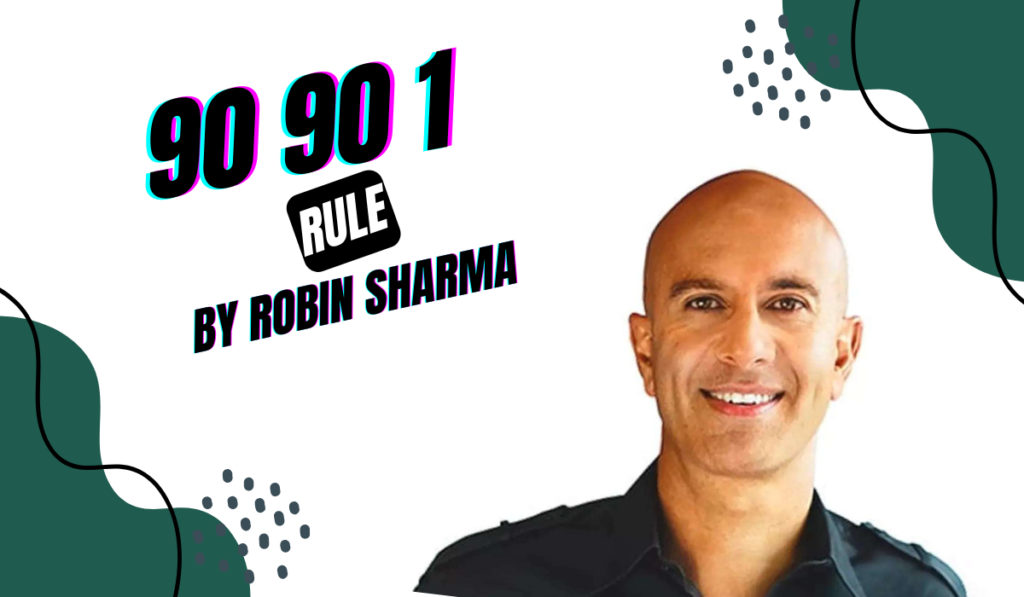

You always seem to address the relevant topics that I’m genuinely interested about. Thank you for that!
Your article helped me a lot, is there any more related content? Thanks!